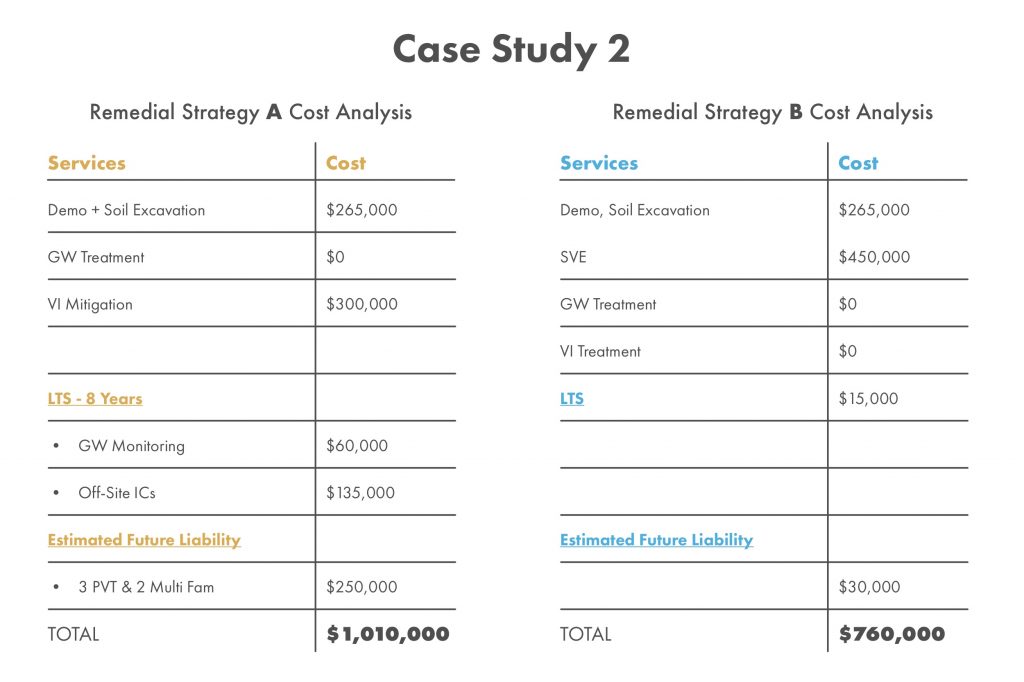A shortsighted view during environmental remedial planning can make it tempting to favor short-term over long-term savings for dry cleaner cleanups. However, when looking at the entire cleanup process and all associated costs, the need to balance present-day cleanup efforts with anticipated future costs becomes far more important.
With perchloroethylene (Perc; PCE) and other chlorinated solvents, the threat of future exposure does not readily go away. These lingering contaminants may present serious problems for future environmental cleanup costs and long-term environmental liability.
In this article, I’ll share why it’s important to work with an environmental consultant who understands the value and significant cost savings that can be realized by choosing more active remedy instead of long-term stewardship.
The strategic options for eliminating contamination exposure pathways and attaining regulatory closure can have vastly different costs when it comes to future liabilities and long-term stewardship that will be required following regulatory closure. For example, source removal can be a relatively large short-term expense compared to a vapor mitigation system. In fact, that same vapor mitigation system might end up costing far more over time than source removal if the system is not properly maintained or the building on which it has been installed remains in use for a long time without any meaningful remedy to the contaminant source.
Look at the total lifecycle cost when planning your remedial strategy
Post-closure monitoring, legal risk and administrative costs really add up over time. When dealing with environmental issues, regulatory closure is often seen as the end goal. While regulatory closure can be attained through various strategies, most revolve around the elimination of exposure pathways, at least in part. Regulatory agencies typically prefer a remediation strategy where a large amount of contamination is removed, but when push comes to shove, they usually will approve remedies with little or no contaminant reduction if the risk of exposure to people is controlled. Because of this, it has become increasingly clear that regulatory closure should be viewed as only an interim milestone when dealing with contaminated properties.
Proper cost-analysis that takes all these factors into account can help you find a balance between short-term and long-term costs and make decisions that are right for you. There is a reverse relationship between money spent on immediate cleanup versus the costs of stewardship and the often-overlooked component of potential legal damages resulting from dry cleaning contaminants left behind. The demand of cash-flow considerations in most businesses, especially small businesses like dry cleaners, can really drive decisions regarding remedial planning. By looking at the total lifecycle cost during the decision-making process and attempting to keep your sights on the longer game, it could save hundreds of thousands of dollars over time.
Whether we’re treating the contaminants in soil, groundwater, or vapor directly or implementing a mitigation system to cut off the pathway, the goal of any environmental remedial strategy is to eliminate exposure.
Understanding the decisions in selecting an environmental remediation strategy
The following case studies provide a helpful guide for property owners, developers and environmental professionals to consider when evaluating remedial efforts vs. long-term stewardship. The cases outlined are actual sites where EnviroForensics was involved in recommending and then implementing an effective remedial plan and ultimately saving both time and money in addressing the environmental contaminants of concern.
The costs of future legal liability included in our case studies below were estimated by experienced attorneys who performed an analysis taking court cases nationwide and assigning a higher cost component for prevalent claims in similar cases. Alternatively, in a situation where claims were not made, they assigned estimated damages to parcels that may be potentially affected. The cost examples presented are case-specific and subject to margins of variability.
Case Study 1: A Dry Cleaning Site Uses Enhanced Reductive Dechlorination (ERD) Approach to Achieve Site Goals and Lower Lifecycle Costs and saves $420,000.
This dry cleaning site had PCE contamination that extended beneath several buildings, including residential property impacts that were present in the soil, and exceeded direct contact thresholds and the migration groundwater standards. The groundwater plume was also expanding and contributed directly to vapor intrusion (VI) exposure issues. VI mitigation was necessary in both the source area and at downgradient residential structures.
These were the two remedial strategies considered.
Remedial Strategy A:
1. Impacted soil would be excavated to promote future contaminant plume stability
2. Institutional controls would be implemented to cut off exposure pathways from the groundwater. Institutional controls typically consist of groundwater usage restriction (i.e. no drinking water wells allowed) but requirements vary from state to state
3. VI mitigation would be installed and maintained
Remedial Strategy B:
1. Impacted soil would be removed
2. Groundwater plume would be treated in situ via amendment injections
Comparing the two strategies, the upfront cost of Strategy A is lower as there is no cost associated with groundwater treatment. However, as can be seen in the cost analysis of Strategy B, by removing the groundwater contaminant reservoir, the cost of groundwater monitoring and VI mitigation are eliminated. Future liability is also significantly reduced because exposure pathways to outlying properties would be cut off.
The Results
Based on projected cost savings, the client chose to implement Strategy B and long-term VI issues were eliminated by virtue of removing the groundwater impacts, and short-term VI mitigation implementation where there were known exposure pathways. Shortly after the remedial injections, PCE concentrations across the site sharply decreased, as expected. While remediation is ongoing, post-injection PCE concentrations have remained at non-detect.

The total cleanup costs, including investigation and remediation efforts, was $1,450,000. By spending $200,000 upfront to remediate the groundwater, the client avoided long-term expenditures and achieved a lifecycle cost savings of $420,000.
Case Study 2: A Multi-Residence Site’s Remedial Approach Mitigates Vapor Intrusion and Saves $250,000
This multi-residence site had a large soil gas plume located deep in the soil. The contaminant plume was under a seven story multi-family residential unit onsite and several residential buildings offsite. There was significant contamination onsite and the soils held very high vapor concentrations. There were complete VI exposure pathways at numerous offsite properties with basements, so interim measures were installed to mitigate risk during the investigation process.
These were the two remedial strategies considered:
Remedial Strategy A:
1. The onsite building would be demolished
2. Shallow soils would be excavated
3. Institutional controls would be implemented to restrict groundwater usage
4. VI mitigation would remain in place
Remedial Strategy B:
1. The onsite building would be demolished
2. Shallow soils would be excavated and stabilized with chemical oxidant
3. A soil vapor extraction (SVE) system would be installed
Neither remedial strategy included groundwater treatment since the primary concern was the vapor intrusion. With Strategy A, the costs are deferred, leaning towards keeping present-day dollars and instead opting to gamble on the costs of long-term liabilities and stewardship costs. With Strategy B, the upfront costs are significant, due primarily to the capital expenditure required for the installation and operation of the SVE system. The payoff is that the cost of long-term stewardship, VI mitigation and potential future liabilities would be greatly reduced or eliminated altogether because of the contaminant mass
therefore the risk, would be removed.
The Results
Favoring a more aggressive remedial approach, the remediation plan that was implemented was Strategy B. The costs of the anticipated long-term stewardship program were significantly reduced from an estimated $195,000 to $15,000, requiring only occasional institutional control monitoring for groundwater usage. While the initial costs of the SVE were high, the system was well-engineered and achieved a remarkable radius of influence, successfully eliminating the liability posed by the vapor in the deep soil reservoir. Because the treatment removed the vapor, any VI concerns were alleviated.
The total cost of cleanup including investigation and remedial efforts came to $1,650,000. The major difference between the two strategies was the implementation of the SVE system which cost $450,000 in the short-term but garnered $250,000 in lifecycle cost savings by reducing the cost of long-term stewardship, VI mitigation and potential legal damages.

Note that although strategy B is much cheaper, almost all of the money gets spent in the first two years, whereas in strategy A half the costs get deferred.
In these two case studies, you can see that there are situations when dry cleaners and real estate developers should take the full picture of risk management and future liability into consideration when planning for cleanup. It’s not always the wisest decision financially to do as little active cleanup as possible. Your environmental consultant and attorney should be showing you the whole picture and looking out for your best interests. Make sure they have the vision to do it for the long haul.

